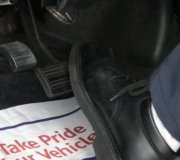You are overlooking one important fact. You are doing something custom that would never be done by any manufacturer, so anything you add is also going to be a custom job. Every car has bump stops to cushion the feel when the suspension bottoms out, and to limit suspension travel so brake hoses won't be torn and control arm bushings won't be stressed. They only do their job when the vehicle is at proper ride height.
Rubbing tires means you did something to reduce the vehicle's braking ability, handling, and steering response. Every manufacturer spends thousands of hours figuring out how to make those characteristics the best as possible to outclass the competition. None of us are going to improve on that. What you need to do is determine if the rubbing is caused by the car body moving up and down, or by how far the steering system is turned. That will tell you what you have to limit. Limiting steering travel is not something easy to do. There are adjustable mechanical stops on some older trucks and motor homes, but those were mainly to prevent the system from turning so far that the linkage would bind and make returning from a full turn difficult. Other than that, steering travel has always been limited by the range of the steering gear box or rack and pinion steering gear.
When ride height and suspension travel is the issue, you have to consider removing the bump stops or installing longer ones. They have a variety of mounting methods so you have to find something compatible with your car. That is easier to do with light trucks because there are plenty of variations already from the manufacturer, and they all generally use the same style of bump stop, but with different lengths. Manufacturers tend to stick with what has worked in the past, and using a previous design means less time spent on product development for a new model or year. For that reason, start by searching through other Nissan products for the last few years. I use the Rock Auto web site for reference every day. They list dimensions and show numerous photos of their parts
You can also consider replacing the springs with stronger ones so the body does not drop so much when hitting bumps. The problem here is spring strength and length are built in for a specific application. Figuring out if a certain pair will reduce suspension travel without sacrificing comfort too much will be a trial and error affair. Many years ago, when air conditioning was a less-popular option, it added enough weight to the front of a car that the springs were stronger on cars ordered with AC. If those are used on a car without AC, it will sit up too high, although that may be hard to notice. Today you will find different springs depending on the engines available for a car model. V-6 engines weight more than four-cylinder engines, so the springs will be stronger and longer. Even though they start out longer, the added engine weight will make the car sit at the proper ride height.
Instead of looking for stronger springs, there are inserts that will do something similar. They come in a variety of styles, but they all have the same goal. That is to restore proper ride height to a car that has springs that are sagged from age, but not quite to the point the suspension height falls outside the published legal limits. As an alignment specialist, I understand how incorrect ride height adversely affects a car and tire wear, even when the numbers on the alignment computer look good. Ethically I cannot tell a customer they must have their springs replaced if they want me to align their car and solve their tire wear issues, if the ride height is badly sagged but still just within manufacturer's limits. I can convince them to let me install a set of spacers to help the weak springs get back to where they should be. These spacers are considered a temporary fix until such time as the springs are replaced. They do not do much for a car that is still at normal ride height, but in your case, they might add enough load-carrying capacity to reduce how much the body drops on bumps in the road.
Sunday, July 30th, 2017 AT 10:06 PM


